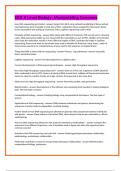OCR A Level Biology: Manipulating Genomes
How DNA sequencing got started - answer-Sanger first did it using radioactive labelling of bases and gel
electrophoresis, done manually so took lots of time, radioactive bases swapped for fluorescent bases,
led to automation and scaling up of process, led to capillary sequencing used in HGP
Principles of DNA sequencing - answer-DNA mixed with different chemicals, PCR carried out in a thermal
cycler, DNA polymerase builds up new strand with the nucleotides as part of PCR, addition of terminator
base stops the replication, results in many different lengths of DNA, separated by length in capillary
sequencing, fluorescent mark on terminator base used to identify the final base using 'lasers', order of
bases shows sequence for complementary strand, used to find sequence of original strand
Things that DNA is mixed with for sequencing - answer-Primers, Taq polymerase, normal nucleotide
bases, terminator bases
Capillary sequencing - answer-Gel electrophoresis in capillary tubes
Current developments in DNA sequencing techniques - answer-High throughput sequencing
How does high throughput sequencing work? - answer-Done on a flow cell, fragments of DNA attached
slide, replicated in situ by PCR, clusters of identical DNA strands form, addition of fluorescent terminator
bases can stop the reaction to take an image, clusters all sequenced at the same time
Other terms for high-throughput sequencing - answer-Massively parallel, next-generation
Bioinformatics - answer-Development of the software and computing tools needed to analyse biological
data. The best type of science.
Computational biology - answer-Studying biology using computational techniques. The best type of
science
Applications of DNA sequencing - answer-GWAs between individuals and species, determining the
sequences of amino acids in polypeptides, synthetic biology
Further detail on how DNA sequencing has allowed for genome wide comparison between individuals
and species - answer-Show patterns of inherited DNA, show diseases that we are vulnerable to, affects
epidemiology
How has DNA sequencing allowed for the study of evolutionary relationships? - answer-Compare the
sequences from different organisms, rate of mutation used to figure out when the organisms had a
common ancestor
Questions that DNA sequencing can help with - answer-Studying genotype-phenotype relationship,
epidemiology, evolutionary relationships
Fields that contribute to research into genotype-phenotype relationships - answer-Bioinformatics,
computational biology, proteomics
, Reasons why the DNA sequence doesn't completely determine the amino acid sequence in a
polypeptide - answer-Spliceosomes, protein modification
Spliceosomes - answer-Enzyme complexes that join exons together in any order
Protein modification - answer-Length might change to give other proteins
Things that epidemiology covers - answer-Finding source of infection, identifying antibiotic resistant
strains of bacteria, tracking the progress of an outbreak, identifying drug targets in a genome
Uses of synthetic biology - answer-Genetic engineering, use of biological systems in industry, synthesis
of new genes to replace faulty genes, synthesis of new organisms
Example of production of new genes to replace faulty genes - answer-Replacing faulty genes in cystic
fibrosis
Example of synthesis of new organisms - answer-Genome of a bacterium made and put in a bacterium
Introns - answer-Non-coding regions of DNA that are removed from mRNA before translation
Satellite DNA - answer-Short sequences of DNA found in introns, centromeres and telomeres that are
often repeated
Other term for satellite DNA - answer-Variable tandem number repeats
Microsatellite - answer-2 to 4 bases that are repeated 5 to 15 time
Other term for micro satellite - answer-Short tandem repeats
How are satellites inherited? - answer-Always in the same place on chromosomes, number of repeats
varies between individuals, number of repeats inherited from parents
DNA profiling - answer-Producing an image of the patterns in DNA
Stages of DNA profiling - answer-Extract the sample, use PCR to get many copies, digest the sample with
restriction endonucleases which cut at specific points in introns, fragments contain a mixture of mini
and microsatellite regions, separate the fragments by electrophoresis, add radioactive or fluorescent
probes, bind to complementary strands in hybridisation, take X-ray images or put under UV light to see
the pattern
Process of electrophoresis - answer-Agarose gel with wells in the bottom, fragments with known lengths
in first and last wells, electric current put through the plate, DNA moves towards the positive electrode,
rate of movement depends on size of DNA fragment, gel placed in alkaline buffer solution to denature
the DNA fragments, bases exposed, transferred to nitrocellulose paper by Southern blotting
Process of Southern Blotting - answer-Nitrocellulose paper placed on top of the cell, covered with sheets
of absorbent paper, DNA drawn up in alkaline solution by capillary action, fixed in place by UV light




